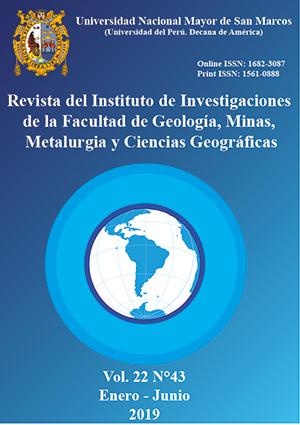Genetic zoning of the mineralization and its relationship with the extraction and recovery of minerals in the area of the Corona Deposit
DOI:
https://doi.org/10.15381/iigeo.v22i43.16682Keywords:
Porphyry; deposit; gold; copper; occurrence; alteration; domainsAbstract
The Corona deposit is one of the 14 known Tertiary deposits of Cu-Au-Mo and one of the 19 epithermal deposits of gold and silver located on the eastern slope of the western cordillera of the Andes, in the metallogenic province of Cajamarca (CMP) of northern Peru. Corona’s copper and gold deposit is typical of porphyry-type mineralization that includes stockworks structures of: (a) Potassium alteration, (b) sericite-chlorite-clay, (c) quartz-sericite-pyrite, (d) Orange clay (OC).
As part of the development of the operations of the mine, two diamond drilling programs were carried out in 2010 and 2011 in the Corona pit, with the obtaining of witnesses or drill holes for their description and geological interpretation, where the alterations and mineralogical domains were identified. Each of the drillings that were extracted and with the subsequent geochemical sampling that helped to define and interpret the geology and geochemistry of each drill.
This is how the Corona deposit is defined as a typical copper and gold porphyry deposit with an overprint of silica structures with high gold values, but also with contaminants.
Downloads
Published
Issue
Section
License
Copyright (c) 2019 José Enrique Vereau Jave

This work is licensed under a Creative Commons Attribution-NonCommercial-ShareAlike 4.0 International License.
AUTHORS RETAIN THEIR RIGHTS:
a. Authors retain their trade mark rights and patent, and also on any process or procedure described in the article.
b. Authors retain their right to share, copy, distribute, perform and publicly communicate their article (eg, to place their article in an institutional repository or publish it in a book), with an acknowledgment of its initial publication in the Rev. Inst. investig. Fac. minas metal cienc. geogr.
c. Authors retain theirs right to make a subsequent publication of their work, to use the article or any part thereof (eg a compilation of his papers, lecture notes, thesis, or a book), always indicating the source of publication (the originator of the work, journal, volume, number and date).






